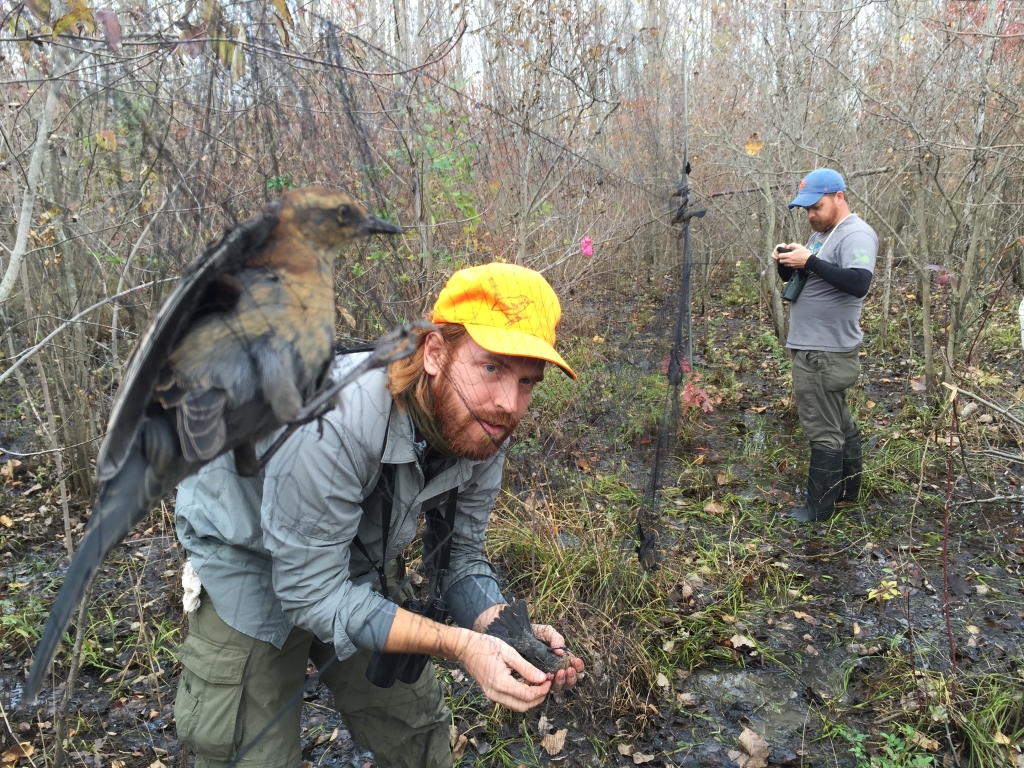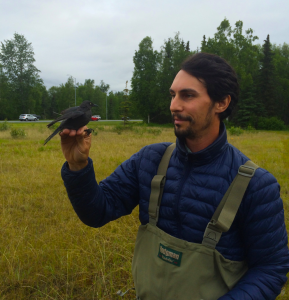Current Rusty Blackbird Projects
Rusty Blackbird Migratory Connectivity Project
Luke L. Powell1, Jim Johnson2, Erin Bayne3, Carol Foss4, Patti Wohner4 Marian Snively5 and Peter P. Marra1
1Smithsonian Migratory Bird Center; 2US Fish & Wildlife Service, Anchorage, AK; 3University of Alberta, Edmonton; 4New Hampshire Audubon; 5Alaska Department of Fish & Game
As part of the Smithsonian Migratory Connectivity Project, we are using the latest tracking technologies to understand Rusty Blackbird migratory connectivity and migratory routes. Earlier research with stable isotopes and light level geolocators suggests that Rusty Blackbirds have a migratory divide between east and west, with western breeding populations wintering in the Mississippi River valley and eastern populations wintering in the southeast coastal plain. With recent advances in miniaturization technology, we can now attach tiny GPS units to Rusty Blackbirds that can mark migratory routes and wintering locations with 10m precision. In a range-wide effort, partners from Anchorage, AK, northeastern Alberta and northern New Hampshire are attaching these mini GPS units to Rusties over a several year period. We are looking for more collaborators on this project, so please let us know if you are interested in joining our effort!
Rusty Blackbird Breeding Ecology in Northern New Hampshire
Carol Foss and Patti Wohner, New Hampshire Audubon
Since 2009 data has been collected on nesting locations and success in the Androscoggin River watershed area. The project has taken many additional aspects since then with banding efforts, post-fledging telemetry, and migratory tracking with Lotek Nanotags using the Motus network, to mention a few.
Rusty Blackbird Spring Migration Blitz
More information on the spring blitz here.
Rusty Blackbird Migratory Ecology on Lake Erie
James “Jay” Wright, The Ohio State University
Jay is currently studying the migratory stopover ecology of Rusty Blackbirds on the shores of western Lake Erie as part of Dr. Chris Tonra’s lab group . The Rusty Blackbird Spring Migration Blitz identified this region as perhaps the most heavily used flyway for the species, which makes it an ideal location for studying their Fall and Spring migratory habits. Jay is capturing Rusty Blackbirds in Ohio and Michigan and outfitting individuals with nanotag radio transmitters, which allow him to monitor their movements using both hand tracking and an automated telemetry tower array. The tags allow Jay to identify diurnal foraging sites and nocturnal roosting sites, stopover duration and survival, and fidelity to particular stopover sites over multiple migration seasons. Jay is also collecting tissue and fecal samples from captured birds in order to 1)determine the breeding and wintering origins of Rusties migrating through the region and 2) describe their diet during stopover events.

Jay Wright (L) and his graduate advisor Dr. Chris Tonra extract Rusty Blackbirds from a mist net at Ottawa National Wildlife Refuge in northern Ohio. Photo by Luke L. Powell.


